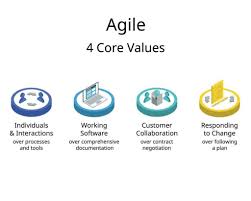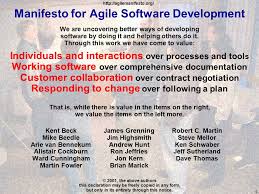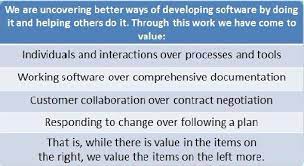The Agile Manifesto in Software Development
Agile software development is a methodology that emphasizes flexibility, collaboration, and customer satisfaction. At the core of agile development is the Agile Manifesto, a set of values and principles that guide the development process.
The Four Core Values of the Agile Manifesto:
- Individuals and interactions over processes and tools
- Working software over comprehensive documentation
- Customer collaboration over contract negotiation
- Responding to change over following a plan
These values prioritize people and their interactions, working software, customer feedback, and adaptability over rigid processes and plans. By focusing on these values, agile teams can deliver high-quality software that meets customer needs efficiently.
The Twelve Principles of the Agile Manifesto:
- Customer satisfaction through early and continuous delivery of valuable software.
- Welcome changing requirements, even late in development.
- Deliver working software frequently, with a preference for shorter timescales.
- Business people and developers must work together daily throughout the project.
- Build projects around motivated individuals. Give them the environment and support they need, and trust them to get the job done.
- The most efficient method of conveying information to and within a development team is face-to-face conversation.
- Working software is the primary measure of progress.
- Agile processes promote sustainable development. The sponsors, developers, and users should be able to maintain a constant pace indefinitely.
- Continuous attention to technical excellence and good design enhances agility.
- Simplicity–the art of maximizing the amount of work not done–is essential.
- The best architectures, requirements, and designs emerge from self-organizing teams.
- At regular intervals, the team reflects on how to become more effective, then tunes and adjusts its behavior accordingly.
The Agile Manifesto has revolutionized software development by promoting collaboration, adaptability, customer focus, and continuous improvement. By following these values and principles, agile teams can deliver high-quality software that meets customer needs effectively in today’s fast-paced digital world.
Understanding the Agile Manifesto: Key Questions and Insights on Software Development
- What is the Agile Manifesto in software development?
- What are the core values of the Agile Manifesto?
- How does agile software development prioritize individuals and interactions?
- Why is working software valued over comprehensive documentation in agile development?
- How does customer collaboration play a key role in agile software development?
- Why is responding to change prioritized over following a plan in agile methodology?
- What are the twelve principles of the Agile Manifesto and how do they guide software development practices?
- How has the Agile Manifesto revolutionized software development processes?
What is the Agile Manifesto in software development?
The Agile Manifesto in software development is a set of values and principles that prioritize flexibility, collaboration, and customer satisfaction in the development process. It emphasizes the importance of individuals and interactions over processes and tools, working software over comprehensive documentation, customer collaboration over contract negotiation, and responding to change over following a plan. By adhering to these core values, agile teams can deliver high-quality software that meets customer needs efficiently while adapting to changing requirements throughout the development lifecycle.
What are the core values of the Agile Manifesto?
The core values of the Agile Manifesto in software development emphasize the importance of individuals and interactions over processes and tools, working software over comprehensive documentation, customer collaboration over contract negotiation, and responding to change over following a plan. These values prioritize people-centric approaches, continuous delivery of functional software, customer engagement, and adaptability in responding to evolving project requirements. By adhering to these core values, agile teams can foster collaboration, deliver value-driven solutions efficiently, and remain responsive to changing needs throughout the development process.
How does agile software development prioritize individuals and interactions?
Agile software development prioritizes individuals and interactions by valuing direct communication and collaboration among team members over relying solely on processes and tools. This emphasis on people recognizes that effective teamwork, clear communication, and close collaboration are essential for successful software development projects. By fostering a culture that values individuals and their interactions, agile teams can better understand each other’s perspectives, share knowledge, address challenges collectively, and ultimately deliver high-quality software that meets customer needs efficiently.
Why is working software valued over comprehensive documentation in agile development?
In agile development, working software is valued over comprehensive documentation because the primary goal is to deliver a product that meets the customer’s needs efficiently. By prioritizing working software, agile teams can quickly iterate on the product based on customer feedback and adapt to changing requirements. While documentation is important, excessive focus on comprehensive documentation can slow down the development process and lead to potential misinterpretations or misunderstandings. Working software serves as a tangible representation of progress and allows for more effective collaboration between team members and stakeholders, ultimately leading to a better end product that aligns with the customer’s expectations.
How does customer collaboration play a key role in agile software development?
Customer collaboration plays a crucial role in agile software development by ensuring that the final product meets the needs and expectations of the end users. By actively involving customers throughout the development process, agile teams can gather valuable feedback, insights, and requirements directly from those who will be using the software. This collaborative approach helps in building a product that aligns with customer preferences, enhances user experience, and ultimately leads to higher customer satisfaction. Additionally, continuous customer collaboration fosters transparency, trust, and communication between the development team and stakeholders, resulting in a more successful and impactful software solution.
Why is responding to change prioritized over following a plan in agile methodology?
In agile methodology, responding to change is prioritized over following a plan because the software development process is inherently dynamic and unpredictable. By embracing change and being adaptable, agile teams can quickly adjust to new requirements, market conditions, or customer feedback. This flexibility allows teams to deliver valuable software that meets the evolving needs of stakeholders efficiently and effectively. Prioritizing responding to change over following a rigid plan enables agile teams to stay responsive, innovative, and focused on delivering high-quality solutions that add real value to the end users.
What are the twelve principles of the Agile Manifesto and how do they guide software development practices?
The twelve principles of the Agile Manifesto serve as guiding principles for software development practices. They emphasize customer satisfaction through early and continuous delivery of valuable software, welcoming changing requirements, delivering working software frequently, fostering collaboration between business people and developers, prioritizing motivated individuals and face-to-face communication, measuring progress by working software, promoting sustainable development practices, focusing on technical excellence and good design, valuing simplicity and self-organizing teams, and encouraging regular reflection for continuous improvement. These principles guide software development teams in adopting agile methodologies to prioritize customer needs, enhance collaboration, adapt to changes efficiently, maintain a sustainable pace of work, and continuously strive for excellence in delivering high-quality software products.
How has the Agile Manifesto revolutionized software development processes?
The Agile Manifesto has revolutionized software development processes by shifting the focus from rigid plans and processes to flexibility, collaboration, and customer satisfaction. By prioritizing individuals and interactions over tools and processes, working software over documentation, customer collaboration over contracts, and responding to change over following a plan, the Agile Manifesto has enabled teams to adapt quickly to evolving requirements and deliver value to customers more efficiently. This approach has transformed the way software is developed by promoting continuous improvement, teamwork, and a customer-centric mindset, ultimately leading to higher quality products delivered at a faster pace.



